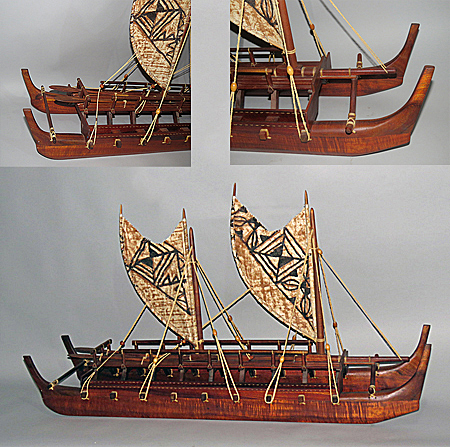
Owner: HWMC
Catalog#: 2OC-OTHR-21
Ritual Symbolism
New Zealand - Māori waka ‘Haunui’ (model)
New Zealand
Craftsman Unknown
Wood, fiber
ca. 2009
Height: 27 in; Width: 48 in; Depth: 13.5 in
Other – Ritual Symbolism
The Māori settlement of New Zealand was due to repeated journeys to and from possibly the Marquesas Islands where they claim their ancestral homeland, Hawaiiki. At first the Māori people built boats by lashing-together their voyaging canoes that were driven by Oceanic lateen (triangular) sails. Later in Aotearoa (the contemporary Māori language name for New Zealand), they added paddle-power to their large military canoes called waka taua (waka means “canoe” and taua means “army” or “war party”). The earliest remains of the waka date back to about 1400. Since the 1970s about eight of these large double-hulled canoes have been constructed for oceanic voyaging to other parts of the Pacific.
This is a model of the Māori waka ‘Haunui,’ a display of a Waka Hourua, which was a traditional double-hulled, ocean-going canoe for American Samoa that was given the name ‘Va’atele.’ In 1990, the 150th anniversary of the signing of the Treaty of Waitangi in 1840 was celebrated by the building of a great fleet of waka taua by different iwi (tribes). Then in 2009, the Okeanos Foundation for the Sea and Salthouse Boatbuilders built a fleet of vaka moana / waka hourua with fibreglass hulls. One of these, the ‘Haunui,’ was gifted to the Te Toki Voyaging Trust in New Zealand. Since then, the Māori renaissance has continued to embrace their earlier tradition of the oceanic sailing waka (the Māori spelling of vaka).
Reference: https://www.flickr.com/photos/147023660@N06/40163524753; https://en.wikipedia.org/wiki/Waka_(canoe)#cite_note-22
